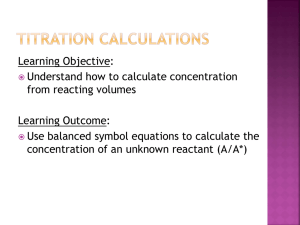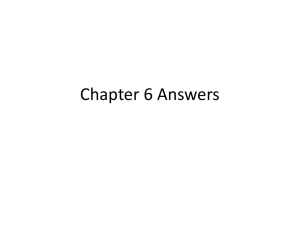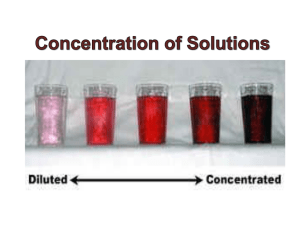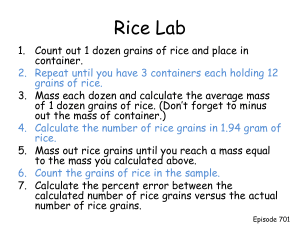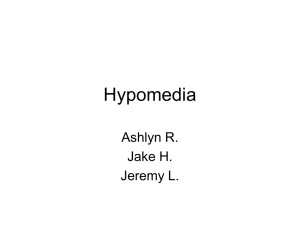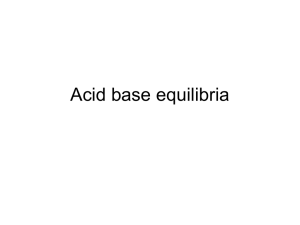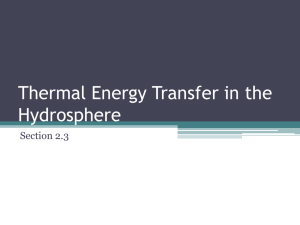Heat/Cal.
advertisement
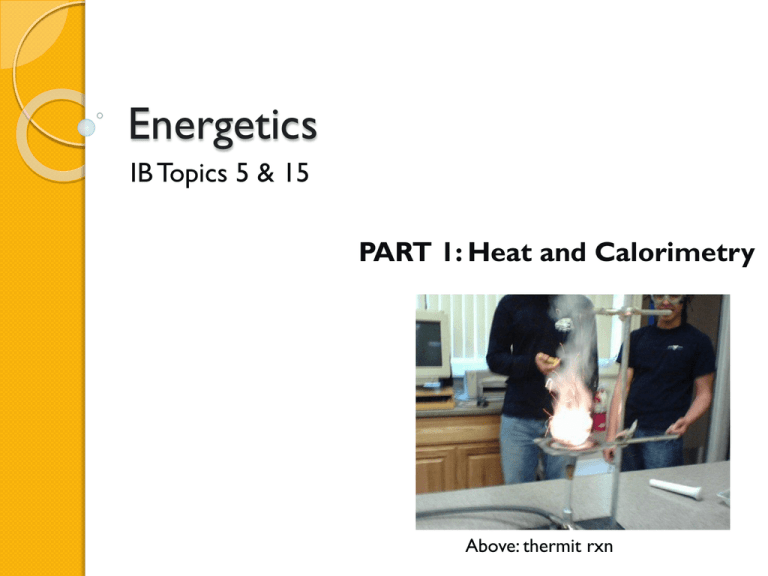
Energetics IB Topics 5 & 15 PART 1: Heat and Calorimetry Above: thermit rxn Energy: a measure of the ability to do work. Work: to move an object against an opposing force. Energy (J) = Force (N) x Distance (m) Forms of energy include: heat, light, sound, electricity, and chemical energy (energy released or absorbed during chemical rxns) Enthalpy (H): a measure of internal energy stored in a substance. Absolute value of enthalpy of reactants cannot be known, nor can enthalpy of products in a rxn. Enthalpy change (H) in a rxn can be measured (difference between reactants and products). Standard enthalpy change of a rxn (Hϴ): measured at pressure = 1 atm; temp = 298 K EXOTHERMIC & ENDOTHERMIC RXNS Exothermic rxns: release energy in the form of heat (because bonds in the products are stronger than the bonds in the reactants); decreasing enthalpy has neg. sign (H < 0) Diagram: reactants Enthalpy, H H = negative products extent of rxn EXOTHERMIC & ENDOTHERMIC RXNS Endothermic rxns: absorb energy in the form of heat; increasing enthalpy, positive value (H > 0) Diagram: products Enthalpy, H H = positive reactants extent of rxn TEMPERATURE AND HEAT Heat: a measure of the total energy in a given amount of a substance (and therefore depends on the amount of substance present). TEMPERATURE AND HEAT Temperature: a measure of the “hotness” of a substance. It represents the average kinetic energy of the substance (but is independent of the amount of substance present). TEMPERATURE AND HEAT Example: Two beakers of water. Both have same temperature, but a beaker with 100 cm3 of water contains twice as much heat as a beaker containing 50 cm3. Same temp, but MORE HEAT TEMPERATURE AND HEAT The increase in temp. when an object is heated depends on The mass of the object The heat added The nature of the substance (different substances have different “specific heat” values) CALORIMETRY The enthalpy change for a rxn can be measured experimentally by using a calorimeter. bomb calorimeter simple calorimeter (a.k.a. “coffee cup calorimeter”) CALORIMETRY In a simple “coffee cup” calorimeter, all heat evolved by an exothermic rxn is used to raise temp. of a known mass of H2O. For endothermic rxns, heat transferred from the H2O to the rxn can be calculated by measuring the lowering of the temperature of a known mass of water. Compensating for heat loss: Graph temp. v. time T3 T2 T T1 = initial temp. T2 = max temp. measured T1 T3 = max temp. if no heat loss T = T3 - T1 By extrapolating the graph, the temp rise that would have taken place had the rxn been instantaneous can be calculated. CALCULATION OF ENTHALPY CHANGES (H) The heat involved in changing the temperature of any substance can be calculated as follows: ◦ Heat energy = mass (m) x specific heat capacity (c) x temperature change (T) ◦ (Remember q = mcT from H Chem?) CALCULATION OF ENTHALPY CHANGES (H) Specific heat capacity of H2O = 4.18 kJ kg-1 K-1 ◦ Thus, 4.18 kJ of energy are required to raise the temp of 1 kg of water by one Kelvin. ◦ Note that this is effectively the same as the complex unit J/g°C (from Honors Chem) CALCULATION OF ENTHALPY CHANGES (H) Enthalpy changes are normally quoted in kJ mol-1 for either a reactant or product, so it is also necessary to work out the number of moles involved in the reaction which produces the heat change in the water. Example 1: 50.0 cm3 of 1.00 mol dm-3 hydrochloric acid solution was added to 50.0 cm3 of 1.00 mol dm-3 sodium hydroxide solution in a polystyrene beaker. The initial temperature of both solutions was 16.7 °C. After stirring and accounting for heat loss the highest temperature reached was 23.5 °C. Calculate the enthalpy change for this reaction. Step 1: Write the equation for reaction HCl(aq) + NaOH(aq) NaCl(aq) + H2O(l) Example 1: 50.0 cm3 of 1.00 mol dm-3 hydrochloric acid solution was added to 50.0 cm3 of 1.00 mol dm-3 sodium hydroxide solution in a polystyrene beaker. The initial temperature of both solutions was 16.7 °C. After stirring and accounting for heat loss the highest temperature reached was 23.5 °C. Calculate the enthalpy change for this reaction. Step 2: Calculate molar quantities amount of HCl 1.00 mol L amount of NaOH 1.00 0.050L 0.0500 mol mol L 0.050L 0.0500 mol heat evolved will be for 0.0500 mol Example 1: 50.0 cm3 of 1.00 mol dm-3 hydrochloric acid solution was added to 50.0 cm3 of 1.00 mol dm-3 sodium hydroxide solution in a polystyrene beaker. The initial temperature of both solutions was 16.7 °C. After stirring and accounting for heat loss the highest temperature reached was 23.5 °C. Calculate the enthalpy change for this reaction. Step 3: Calculate heat evolved Total vol. sol’n = 50.0 + 50.0 = 100.0 mL Assume sol’n has same density and specific heat capacity as water, then… Mass of “water” = 100.0 g T = 23.5 – 16.7 = 6.8 °C heat evolved = 100.0g x 4.18J/g°C x 6.8 °C = 2.84 kJ/mol (for 0.0500 mol) H rxn -2.84kJ 0 . 0500 mol 56 . 8 kJ mol neg. value = exothermic Example 2: A student uses a simple calorimeter to determine the enthalpy change for the combustion of ethanol (C2H5OH). When 0.690 g of ethanol was burned it produced a temperature rise of 13.2 K in 250 g of water. a) Calculate H for the reaction C2H5OH(l) + 3O2(g) 2CO2(g) + 3H2O(l) Heat evolved = 250g x 4.18J/g°C x 13.2°C Heat evolved = 13.79 kJ (for 0.015 mol ethanol) H rxn -13.79kJ 0 . 015 mol 920 kJ mol neg. value = exothermic Example 2: A student uses a simple calorimeter to determine the enthalpy change for the combustion of ethanol (C2H5OH). When 0.690 g of ethanol was burned it produced a temperature rise of 13.2 K in 250 g of water. b) The IB Data Book value is -1371 kJ mol-1. Provide reasons for any discrepancy between this and the calculated value above. Not all heat produced is transferred to the water Water loses some heat to surroundings Incomplete combustion of ethanol Example 3:The neutralization reaction between solutions of NaOH and H2SO4 was studied by measuring the temperature changes when different volumes of the two solutions were mixed (hint: just like your molar ratio lab). The total volume was kept constant at 120.0 cm 3 and the concentrations of the two solutions were both 1.00 mol dm-3 (Figure 5.2). Figure 5.2: Temperature changes produced when different volumes of NaOH and H2SO4 are mixed. a) Annotate Fig. 1 appropriately and determine the volumes of the solutions which produce the largest increase in temperature. From the graph: VNaOH = 80 mL VH2SO4 = 120 mL - 80 mL = 40 mL Example 3:The neutralization reaction between solutions of NaOH and H2SO4 was studied by measuring the temperature changes when different volumes of the two solutions were mixed (hint: just like your molar ratio lab). The total volume was kept constant at 120.0 cm 3 and the concentrations of the two solutions were both 1.00 mol dm-3 (Figure 5.2). Figure 5.2: Temperature changes produced when different volumes of NaOH and H2SO4 are mixed. b) Calculate the heat produced by the reaction when the maximum temperature was produced. heat produced = mH2O x cH2O x TH2O Example 3:The neutralization reaction between solutions of NaOH and H2SO4 was studied by measuring the temperature changes when different volumes of the two solutions were mixed (hint: just like your molar ratio lab). The total volume was kept constant at 120.0 cm 3 and the concentrations of the two solutions were both 1.00 mol dm-3 (Figure 5.2). Tf Ti Figure 5.2: Temperature changes produced when different volumes of NaOH and H2SO4 are mixed. b) Calculate the heat produced by the reaction when the maximum temperature was produced. TH2O = Tf - Ti = (33.5 – 25.0) = 8.5 °C Example 3:The neutralization reaction between solutions of NaOH and H2SO4 was studied by measuring the temperature changes when different volumes of the two solutions were mixed (hint: just like your molar ratio lab). The total volume was kept constant at 120.0 cm 3 and the concentrations of the two solutions were both 1.00 mol dm-3 (Figure 5.2). Tf Remember that significant figures for temperatures are always based on the Kelvin temp… thus 8.5 °C is really 8.5°C + 273.15 = 281.2 K (4 sig figs) Ti Figure 5.2: Temperature changes produced when different volumes of NaOH and H2SO4 are mixed. b) Calculate the heat produced by the reaction when the maximum temperature was produced. heat produced = 120.0g x 4.18 J/g°C x 8.5 °C = 4264 J heat produced 4260 J Example 3:The neutralization reaction between solutions of NaOH and H2SO4 was studied by measuring the temperature changes when different volumes of the two solutions were mixed (hint: just like your molar ratio lab). The total volume was kept constant at 120.0 cm 3 and the concentrations of the two solutions were both 1.00 mol dm-3 (Figure 5.2). c) Calculate the heat produced for one mole of NaOH. heat produced 426 4 J n NaOH n NaOH 1.00 heat produced mol L 0.080L 0.080 mol 426 4 J 0.080mol H 53 . 3 kJ mol 53 . 3 kJ mol Example 3:The neutralization reaction between solutions of NaOH and H2SO4 was studied by measuring the temperature changes when different volumes of the two solutions were mixed (hint: just like your molar ratio lab). The total volume was kept constant at 120.0 cm 3 and the concentrations of the two solutions were both 1.00 mol dm-3 (Figure 5.2). d) The literature value for the enthalpy of neutralization is -57.5 kJ mol-1. Calculate the percentage error value and suggest a reason for the discrepancy between the experimental and literature values. 57 . 5 - (-53.3) % error 57 . 5 % error 7 % Example 3:The neutralization reaction between solutions of NaOH and H2SO4 was studied by measuring the temperature changes when different volumes of the two solutions were mixed (hint: just like your molar ratio lab). The total volume was kept constant at 120.0 cm 3 and the concentrations of the two solutions were both 1.00 mol dm-3 (Figure 5.2). d) The literature value for the enthalpy of neutralization is -57.5 kJ mol-1. Calculate the percentage error value and suggest a reason for the discrepancy between the experimental and literature values. 1)The calculated value assumes: • No heat loss from the system • All heat is transferred to the water • The sol’ns contain 120 g of water 2) Uncertainties in the temp., vol. and concentration measurements. 3) Literature value assumes standard conditions. Example 4: 50.0 cm3 of 0.200 mol dm-3 copper (II) sulfate solution was placed in a polystyrene cup. After two minutes, 1.20 g of powdered zinc was added. The temperature was taken every 30 seconds and the following graph obtained. Calculate the enthalpy change for the reaction taking place (Figure 5.3). Figure 5.3: Compensating for heat lost in an experiment measuring temperature changes in an exothermic reaction. Step 1: Write the equation for the reaction. Cu2+(aq) + Zn(s) Cu(s) + Zn2+(aq) Example 4: 50.0 cm3 of 0.200 mol dm-3 copper (II) sulfate solution was placed in a polystyrene cup. After two minutes, 1.20 g of powdered zinc was added. The temperature was taken every 30 seconds and the following graph obtained. Calculate the enthalpy change for the reaction taking place (Figure 5.3). Figure 5.3: Compensating for heat lost in an experiment measuring temperature changes in an exothermic reaction. Step 2: Determine the limiting reagent. 2 0.050L 0.0100 mol 1 mol amount of Zn(s) 1.20g 0.0184 mol 65.37g amount of Cu (aq) 0 . 2 00 mol L Cu2+(aq) is the limiting reactant T Figure 5.3: Compensating for heat lost in an experiment measuring temperature changes in an exothermic reaction. Step 3: Extrapolate the graph to compensate for heat loss and determine T. T = 27.4 – 17.0 = 10.4 °C Example 4: 50.0 cm3 of 0.200 mol dm-3 copper (II) sulfate solution was placed in a polystyrene cup. After two minutes, 1.20 g of powdered zinc was added. The temperature was taken every 30 seconds and the following graph obtained. Calculate the enthalpy change for the reaction taking place (Figure 5.3). Step 4: Calculate the heat evolved in the experiment for 0.0100 mol of reactants. Assume sol’n mass is approx.= mass of 50.0 mL of water Heat evolved = 0.0500g x 4.18J/g°C x 10.4°C Heat evolved = 2.17 kJ Example 4: 50.0 cm3 of 0.200 mol dm-3 copper (II) sulfate solution was placed in a polystyrene cup. After two minutes, 1.20 g of powdered zinc was added. The temperature was taken every 30 seconds and the following graph obtained. Calculate the enthalpy change for the reaction taking place (Figure 5.3). Step 5: Express this as the enthalpy change for the reaction (H). H rxn -2.17kJ 0 . 0100 mol 217 kJ mol neg. value = exothermic
